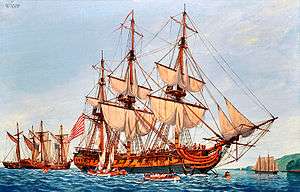USS Confederacy (1778)
USS Confederacy was a 36-gun sailing frigate of the Continental Navy in the American Revolutionary War. The British Royal Navy captured her in March 1781, took her into service for about half-a-year as HMS Confederate, and broke her up in 1782.
 A Revolutionary War painting depicting the Continental Navy frigate Confederacy is displayed at the Navy Art Gallery at the Washington Navy Yard. | |
| History | |
|---|---|
| Name: | USS Confederacy |
| Builder: | Norwich, Connecticut |
| Launched: | 8 November 1778 |
| Fate: | Captured 14 April 1781 |
| Name: | HMS Confederate |
| Fate: | Broken up March 1782 |
| General characteristics | |
| Type: | Frigate |
| Tons burthen: | 959 (bm) |
| Length: |
|
| Beam: |
|
| Depth of hold: |
|
| Complement: | 260 officers and men |
| Armament: |
|
| Service record | |
| Commanders: |
|
Career
She was launched on 8 November 1778 at Chatham (Norwich), Connecticut, and towed to New London to be prepared for sea. From 1 May to 24 August 1779 she cruised on the Atlantic coast under the command of Captain Seth Harding. While convoying a fleet of merchantmen, on 6 June, she and Deane captured three prizes, drove off two British frigates and brought the convoy safely into Philadelphia, Pennsylvania.
On 17 September 1779 Confederacy was ordered to carry the French Minister and his family back to France. Later John Jay, the first American Minister to Spain, his secretary, and family were added to the passenger list. During the passage on 7 November 1779 Confederacy was completely dismasted and almost lost, but managed through the skillful seamanship of Captain Harding to reach Martinique early in December. After repairs, she returned to convoy duty.
Captain Nicholson replaced Harding in on 20 October 1780.
Confederacy was homeward bound from Cape Francois in the West Indies in 1781 with military stores and other supplies and escorting a fleet of 37 merchantmen, when on 14 April she encountered HMS Roebuck (44) and HMS Orpheus (32) off the Delaware Capes. The British ships forced Confederacy to strike her flag.[1] Most of the merchantmen she was escorting escaped. Many of her crew were sent to the old prison hulk Jersey, though some ended up in Mill and Forton prisons.
Fate
_RMG_J5352.jpg)
The Royal Navy took her into service as HMS Confederate, under the command of Captain James Cumming. He paid her off in September 1781. She was broken up at Woolwich in March 1782.[2]
See also
- List of sailing frigates of the United States Navy
- Bibliography of early American naval history
Citations and references
Citations
- "No. 12427". The London Gazette. 29 March 1783. p. 2.
- "NMM, vessel ID 382667" (PDF). Warship Histories, vol xii. National Maritime Museum. Archived from the original (PDF) on 2 August 2011. Retrieved 30 July 2011.
References
- This article incorporates text from the public domain Dictionary of American Naval Fighting Ships.
- This article includes data released under a Creative Commons Attribution-ShareAlike 3.0 Unported UK: England & Wales Licence, by the National Maritime Museum, as part of the Warship Histories project.
External links
- The Frigate Confederacy Papers, including correspondence, bills, receipts and other materials pertaining to the construction of USS Confederacy, are available for research use at the Historical Society of Pennsylvania.